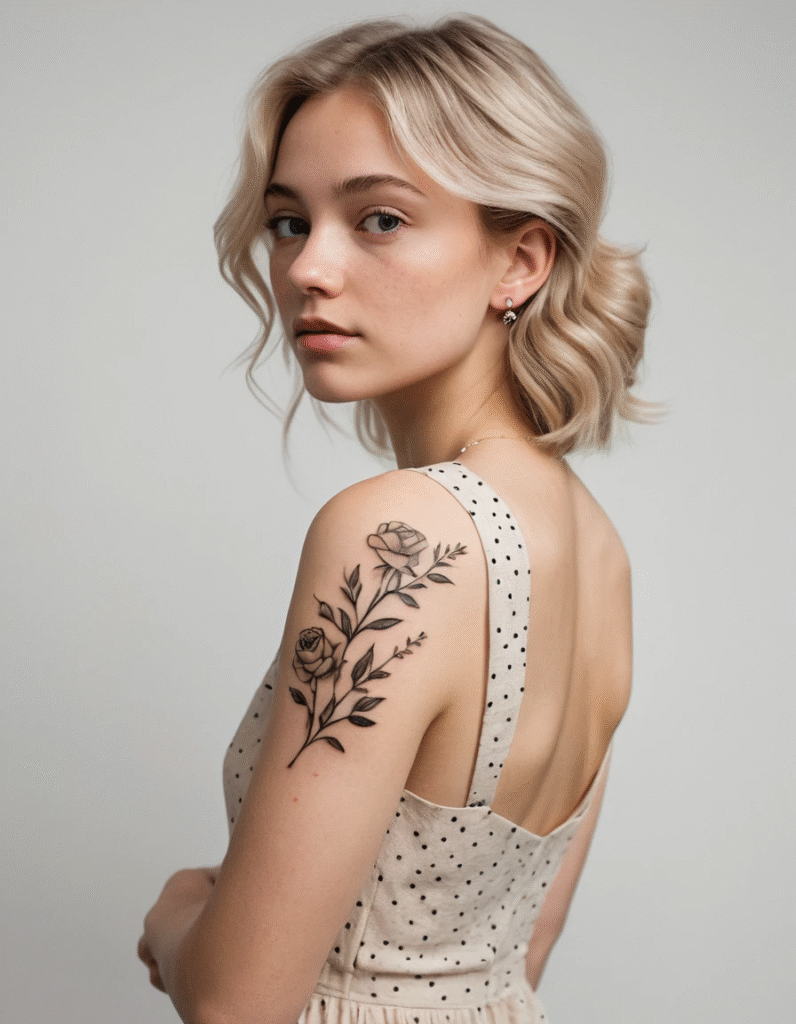In the flourishing landscape of contemporary tattoo artistry, few designs capture the delicate balance between strength and vulnerability quite like botanical tattoos. These intricate compositions—featuring graceful rose stems, cascading wildflower arrangements, and detailed leaf work—transform the skin into living gardens where personal narratives bloom eternal. Far from simple decorative flourishes, these tattoos represent profound expressions of growth, resilience, and our fundamental connection to the natural world, serving as permanent reminders that beauty often emerges from life’s most challenging seasons.
The Ancient Language of Flowers
Humanity’s relationship with botanical symbolism stretches back millennia, with cultures worldwide developing sophisticated flower languages that communicated complex emotions and social messages. From Victorian floriography to ancient Greek mythology, plants have served as vessels for human meaning-making and spiritual connection.
“Botanical tattoos tap into this deep well of symbolic tradition,” explains cultural botanist Dr. Rose Thornfield. “When someone chooses to wear a flowering branch on their skin, they’re participating in an ancient conversation between human consciousness and plant wisdom—a dialogue that speaks to growth, cycles, renewal, and the patient strength required to bloom despite adversity.”
This historical depth explains why botanical tattoos feel both intimately personal and universally resonant, creating connections between individual experience and the timeless patterns of natural growth and seasonal change.
The Poetry of Plant Symbolism
Contemporary botanical tattoos employ rich symbolic vocabularies that speak to multiple layers of personal meaning:
Rose Blooms: Representing love, beauty, passion, and the courage to remain open despite life’s thorns, roses embody the complex interplay between vulnerability and strength.
Stems and Branches: The flowing lines that connect blooms symbolize life’s journey, personal growth, and the underlying strength that supports visible beauty.
Leaves and Foliage: Detailed leaf work represents foundation, grounding, breath, and the quiet work of transformation that happens away from public view.
Thorns and Protective Elements: Rather than aggressive symbols, thorns in botanical tattoos often represent healthy boundaries, self-protection, and the wisdom to defend what matters most.
Bud Formations: Unopened buds suggest potential, future possibilities, and the patient faith required to trust in unseen growth.
“Each botanical element tells part of a larger story,” notes symbolic tattoo researcher Dr. Flora Meaningwright. “A rose with visible thorns might represent someone who has learned to love fearlessly while maintaining healthy boundaries. Cascading wildflowers could celebrate embracing one’s authentic nature. The beauty lies in how universal plant symbolism becomes deeply personal narrative.”

Artistic Mastery in Living Lines
Creating compelling botanical tattoos requires exceptional skill across multiple technical challenges that mirror the complexity of natural plant forms:
Organic Line Quality: Capturing the natural flow and irregular beauty of plant growth requires artists to balance precision with organic spontaneity.
Layered Depth: Multiple overlapping elements—petals, stems, leaves—must create convincing depth while maintaining clarity in each individual component.
Texture Variation: Different plant elements require distinct approaches: smooth petals, textured bark, delicate leaf veins, and flowing stem curves.
Proportional Accuracy: Maintaining realistic relationships between different plant elements while adapting to body contours and tattoo size constraints.
Negative Space Integration: Using untouched skin to create breathing room and highlight the delicate nature of botanical forms.
Shading Subtlety: Creating dimension and life through subtle gradations that enhance rather than overwhelm the natural beauty of plant forms.
“Botanical tattoos are like creating botanical illustrations that must also function as wearable art,” explains nature tattoo specialist Ivy Needlepoint. “You’re capturing the essence of living, growing things in permanent form—honoring both the scientific accuracy of plant structure and the emotional resonance of natural beauty.”
The Science of Natural Beauty
Beyond artistic interpretation, many botanical tattoos incorporate genuine botanical accuracy, requiring artists to understand plant anatomy and growth patterns:
Anatomical Precision: Accurate representation of how petals attach, leaves grow, and stems support flowering structures creates more convincing and beautiful tattoos.
Growth Pattern Understanding: Knowing how different plants naturally develop helps create tattoos that feel alive and organically positioned.
Seasonal Considerations: Some designs represent plants through different growth stages, from bud to full bloom to seed formation.
Species-Specific Details: Clients often request specific flowers with personal meaning, requiring artists to understand the unique characteristics of different plant varieties.
“The intersection of botanical science and tattoo artistry creates incredibly satisfying work,” notes plant-focused tattoo artist Dr. Sage Bloomwright. “When you understand how a rose actually grows—the way petals unfurl, how thorns protect the stem, how leaves position themselves for optimal light—you can create tattoos that feel genuinely alive rather than simply decorative.”
Cultural Gardens and Symbolic Traditions
While botanical symbolism appears across cultures, different traditions bring unique perspectives to flower and plant imagery:
Western Flower Language: Victorian-era floriography created detailed symbolic meanings for specific flowers, with roses representing love, forget-me-nots symbolizing remembrance, and daisies indicating innocence.
Eastern Botanical Wisdom: Traditional Chinese and Japanese culture associates specific plants with virtues, seasons, and life phases—cherry blossoms for ephemeral beauty, bamboo for flexibility and strength.
Indigenous Plant Knowledge: Native plant traditions worldwide offer profound connections between specific botanical species and spiritual or medicinal properties.
Modern Botanical Art: Contemporary botanical tattoos often blend traditional symbolism with personal plant connections—favorite garden flowers, meaningful wildflowers, plants connected to specific memories or places.
Horticultural Heritage: Many clients choose plants connected to family gardening traditions, regional native species, or flowers that hold generational significance.
“What’s remarkable about botanical tattoos today is how they honor both traditional plant symbolism and highly personal connections,” observes cultural anthropologist Dr. Violet Gardenweaver. “Someone might combine a rose for their grandmother’s memory with native wildflowers from their hometown, creating something that’s both symbolically rich and completely individual.”
Personal Cultivation and Growth Metaphors
For many recipients, botanical tattoos serve as permanent reminders of personal growth journeys and life transformations:
“My rose stem tattoo represents my recovery journey,” shares tattoo recipient Maria Rosegarden. “The thorns acknowledge the difficulties I’ve faced, but the blooming rose celebrates my resilience and capacity for beauty. During challenging days, I look at it and remember that growth often requires weathering difficult seasons—but the blooming always comes.”
Others choose botanical designs to honor loved ones, celebrate life transitions, mark spiritual awakenings, or simply express their connection to gardening and natural beauty.
The Psychology of Natural Connection
Choosing to permanently mark one’s body with botanical imagery reflects deeper psychological needs for growth, beauty, and connection to natural cycles:
“Botanical tattoos often appeal to people seeking both grounding and transformation,” explains nature psychology researcher Dr. Lily Rootwise. “They provide connection to natural rhythms and seasonal cycles while also offering symbols of personal growth and resilience. There’s comfort in wearing imagery that reminds us we’re part of the same natural world that creates forests and meadows.”
This psychological framework helps explain why botanical tattoos often bring their wearers a sense of peace and connection, serving as anchors to natural beauty and reminders of their own capacity for growth and renewal.
Placement and Body Integration
The flowing, organic nature of botanical tattoos makes them particularly well-suited to certain body placements that complement natural movement:
Arm Placement: Allows for vertical compositions that can follow natural muscle lines while showcasing the flowing growth patterns of botanical elements.
Wraparound Potential: Longer botanical designs can curve around limbs, creating dynamic compositions that shift and flow with body movement.
Visibility Balance: Arm placement offers flexibility between personal meaning and social sharing, easily styled or displayed according to preference and situation.
Daily Connection: Placement where the wearer can regularly view their tattoo reinforces its personal significance and symbolic power.
Professional Adaptability: Easy to cover for conservative environments while remaining accessible for personal reflection and connection.
“Placement becomes part of how a botanical tattoo functions in someone’s life,” notes body art placement specialist Dr. Stem Positioning. “These tattoos work best where they can be regularly appreciated by their wearer—they’re meant to serve as daily reminders of growth, beauty, and natural connection.”
Technical Preservation and Botanical Longevity
The detailed line work and organic curves in botanical tattoos require specific care approaches to maintain their natural beauty:
Line Quality Maintenance: Organic flowing lines need careful protection during healing to preserve the natural, hand-drawn quality that makes botanical tattoos feel alive.
Detail Preservation: Fine elements like leaf veins and petal edges require attentive aftercare to maintain clarity and definition over time.
Color Considerations: When botanical tattoos include color elements, proper sun protection and moisturizing help maintain vibrancy and prevent fading.
Touch-up Planning: The organic nature of botanical tattoos often allows for natural enhancement over time, with additional elements easily integrated into existing designs.
“Caring for a botanical tattoo is like tending a garden,” explains tattoo preservation expert Marcus Bloomkeeper. “With proper attention and care, these pieces age beautifully, often developing character and depth that enhances their natural appeal over time.”
Seasonal Resonance and Living Symbolism
Many botanical tattoo wearers discover their pieces take on different meanings throughout natural seasons and personal life phases:
“My wildflower cascade feels different in each season,” observes wearer Jennifer Meadowbloom. “In spring, it reminds me of new beginnings and fresh growth. During autumn, it becomes a celebration of cycles and the beauty in letting go. Through winter, it promises that warmth and blooming will return. The same flowers carry me through different emotional seasons of life.”
This temporal dimension adds layers of meaning that deepen over time, making botanical tattoos companions for life’s ongoing cycles rather than static decorative elements.
The Future of Botanical Artistry
As tattoo techniques continue advancing, botanical tattoos are finding new expressions through innovative approaches while maintaining their connection to natural beauty:
Watercolor Integration: Some artists now blend traditional botanical line work with watercolor techniques, creating pieces that look like living botanical illustrations.
Micro-Detail Advancement: Improved equipment allows for increasingly fine detail work, enabling more accurate representation of delicate plant structures and textures.
Botanical Accuracy: Access to detailed botanical references and plant photography enables artists to create increasingly scientifically accurate representations of specific species.
Seasonal Series: Some clients choose to build botanical tattoo collections that represent different seasons or growth stages, creating evolving gardens on their skin over time.
“We’re in an exciting period where botanical tattoos can be both more artistically expressive and more botanically accurate than ever,” notes tattoo innovation researcher Dr. Cosmos Plantwright. “The fundamental appeal of wearing living beauty remains constant, but the possibilities for expressing that connection continue expanding.”
Living Artistry and Natural Wisdom
Perhaps the most profound aspect of botanical tattoos is how they encourage wearers to embrace natural rhythms of growth, rest, and renewal while honoring their individual journey through life’s seasons.
In a world that often demands constant productivity and artificial perfection, these natural companions offer gentle reminders of organic beauty and patient growth. They celebrate the wisdom of trees that grow slowly and deeply, flowers that bloom in their own time, and plants that find ways to thrive in challenging conditions.
Those who choose to adorn their bodies with botanical gardens make profound statements about their relationship with growth, beauty, and the natural world. They declare themselves part of the living community of growing things while celebrating their unique path through life’s seasons, creating personal talismans that bridge human experience with natural wisdom.
Cultivating Beauty in Permanent Gardens
As these living designs continue evolving through contemporary tattoo artistry, botanical tattoos remind us that we are part of the same natural world that creates forests, meadows, and gardens. They invite us to remember that personal growth, like plant growth, happens in seasons—sometimes visible and dramatic, sometimes quiet and underground, but always part of a larger pattern of renewal and transformation.
Whether featuring traditional roses or personal wildflower arrangements, these botanical companions invite us to navigate life with natural wisdom while honoring our individual growth journey. In choosing to wear gardens, we carry with us eternal reminders that we are both temporary bloomers and permanent participants in the ongoing story of growth, beauty, and the patient strength required to flourish in any season.
Through botanical tattoos, we declare our commitment to cultivating beauty, embracing growth, and maintaining hope that spring always follows winter—both in the natural world and in the gardens of our own becoming.


